150 years of the Lord Napier: from boozer to rave squat to artist mecca
From public house to squat rave location to art gallery, it has been over 20 years since a pint was pulled in the Lord Napier. With news that it may reopen, we take a look at the long history of Hackney Wick’s best loved defunct pub.
Sitting just outside Hackney Wick overground station, many visitors will recognise the building from its vibrant exterior, tattooed with brightly coloured tags and political slogans down to every last brick. If your eye wasn’t caught by the rainbow of spray paint, it was drawn to the giant lettering ‘Shithouse to Penthouse’ across the entire west side.
The Lord Napier might be one of the only pubs that still draws a crowd despite being closed since 1995. It attracts a constant stream of photographers and tourists capturing Instagram-able shots, and is even listed as an ‘modern art museum’ on Google. But the pub only got this iconic makeover in 2016, a very recent incarnation in what is a long history of Hackney Wick culture.
Napier, Lord of the factory workers
The pub was licensed in 1868 under the name The White’s Arms, after the original owner Mr White, and advertised for sale shortly after.
The Morning Advertiser of 23 May 1868 said ‘the house is not yet opened for trade, but it is in the immediate neighbourhood of no less than 17 large factories, employing over 2,000 workmen, nearly the whole of whom must pass through the doors of this house going to and returning from their work.’ The idea of dropping in for a pint before work might be a bit outdated to most of us, but the pub has been a local workers’ sanctuary over the course of its century and a half.
The White’s Arms was bought from Mr White at auction shortly after, and renamed the Lord Napier after the noble Scottish family. The area around it was filled with factories and workers’ housing, and the pub was woven into everyday life as a place to relax, socialise, and most importantly, drink beer.
Right in the heart of Hackney Wick, the Lord Napier has witnessed wave upon wave of industrial toil and reinvention. It opened just in time to see the invention of plastic on Wallis Road at Parkesine Works in the 1860s, and sat opposite Carless Capel and Leonard Ltd, the oil refining business of 1872 to 1989 that actually coined the word ‘petrol’.
It was an Ind Coope Brewery pub for most of its lifespan, and changed to Taylor Walker in the 1980s before becoming a free house in 1991, just four years before its closure. From the 1870s till 1995, the Lord Napier was a run-of-the-mill pub in East London supplying pints to thirsty local workers. As Hackney Wick embodied the poverty-stricken East End Dickens wrote about, its pubs couldn’t be further from the gastropubs we’re so familiar with today.
Before the overground came to the Hackney Wick train line, the area was known for violence and danger. It had previously been the Victoria Park station before closing in 1943 after bomb damage from the Blitz, and the derelict station roads attracted violent crime. As much as locals remember the pub fondly for the time they spent there, the Lord Napier appeared in local and national news for robberies and assaults throughout the 20th century, and never recovered from its reputation.
‘Meanwhile in East London, lunatics decorate a building’
After the pub closed in 1995, it started a new kind of life. Squat parties began cropping up in the empty building, and it became a famous spot for illegal raves. The walls began to become stained with its signature graffitied colours, a constantly changing canvas of free expression on the outside and a haven of unbridled fun on the inside.
Rob Star, the owner of Eastern Electrics who has bought the pub, has been heard saying that he often went to illegal raves in the Lord Napier in the early 2000s.
The local authority has since cracked down on the parties and, aside from squatters climbing in through the broken windows, the pub has been boarded up for many years now.
In the mid-2000s Stewart Schwartz took the freehold of the derelict building when the illegal raves were in their last hurrah. Planning issues got in the way of turning it into the artist complex he originally envisioned, and he decided to restore it as a pub at the heart of a community.
In Schwartz’s view, the street art wasn’t a necessary part of the pub — it just became a feature. His new vision was to restore the pub to how it was in its early days, plus some extra love: two-tone green tiles, an upstairs fine dining room, and a roof garden. He could take or leave the graffiti.
But with his permission in July 2016, artist Aida Wilde commissioned a 48 hour takeover of the building by a team of 29 local street artists. She had been living in Hackney Wick through a period of rapid change in the 2010s and wanted to commemorate the times of free expression, honour those who had moved on, and give a voice to those who were still hanging on to the undeveloped Hackney Wick they knew and loved.
‘It was like our blue plaque on the building, it was a way for us to put our mark on [the area],’ Wilde said. Hackney Wick artists including Edwin, Sweet Toof, Mighty Mo, Mobstr, Dscreet, Malarky, Donk, Static, Teddy Baden, Sony, Xenz, and Done came together to turn the old building into the artwork it is today.
‘Gold Peg came out of retirement for it,’ said Wilde, who made an effort to commission as many female artists as male for the project. Of the 29 locals who contributed to the project, only a few remain in Hackney Wick today.
For the first three months, the art was static, with artists returning to repaint parts that had been painted over. After that, Wilde wanted the building to go back to what it had been: a canvas for the local area in a state of constant metamorphosis.
‘We knew the stuff at the bottom was going to be painted over, and that was what we wanted, but we painted the important stuff at the top so it was less likely to change,’ Wilde said. At the heart of it, Wilde wanted a memorial to Hackney Wick’s creative community.
What’s in the stars
After nearly 150 years on the ground and 25 of them closed, the Lord Napier’s renovation is in planning. The license was handed to Rob Star, who owns five pubs as part of Electric Star Pubs, including the Star of Bethnal Green.
ZCD Architects said in their heritage statement that the street art is ‘an important part of the pub’s history’, but it is unlikely to remain in its current iteration. Their planning statement said: ‘Although we recognise the cultural value of the graffiti, in its present state the various artworks give the Lord Napier a messy and abandoned appearance.’
Going into the future, Wilde hopes that the new owners are sympathetic to the area, aware of local artists and the history of pub. ‘For Hackney Wick it represented delapidation, but now it’s the opposite – it creates an atmosphere. Without it Crate [Brewery] would have been a car park.’
For Wilde and other contributing artists, the Lord Napier was a ‘symbol of protest against gentrification’. ‘People can just come and do what they want and it was done quite organically done most of the time. It’s going to have a completely new meaning now.’
ZCD Architects plan to reform the pub into a blank canvas where local artists will be invited to paint, but Wilde doesn’t believe this cuts it: it reverses the whole point of the art, she explained. The art becomes a part of gentrification rather than a statement against it.
As a mirror to the local area it sits in, from working class public house, to rave destination in an undeveloped area, the Lord Napier’s current appearance shines some light on how Hackney Wick’s vibrantly creative scene feels about the changes it has seen in recent years.
As the now-iconic pub prepares for its revamp as the new Lord Napier Star – part of Rob Star‘s Electric Star Pubs empire – you can’t help but wonder just how accurate ‘Shithouse to Penthouse’ is going to be.
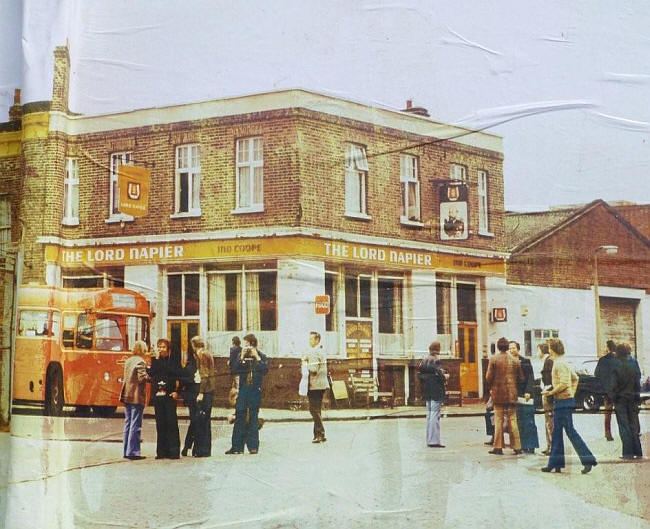
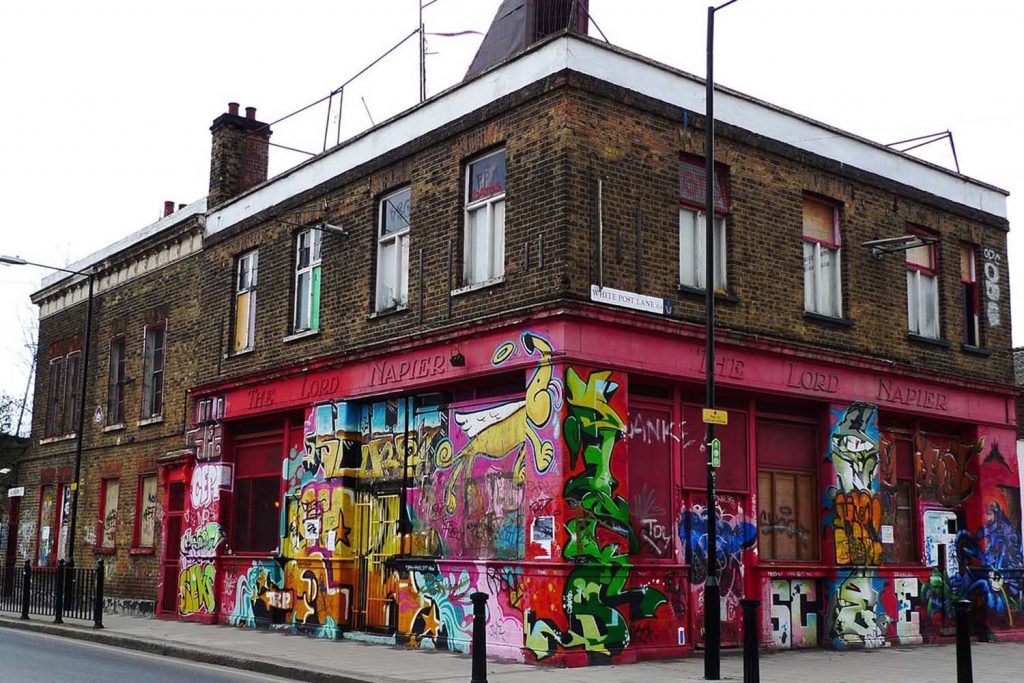
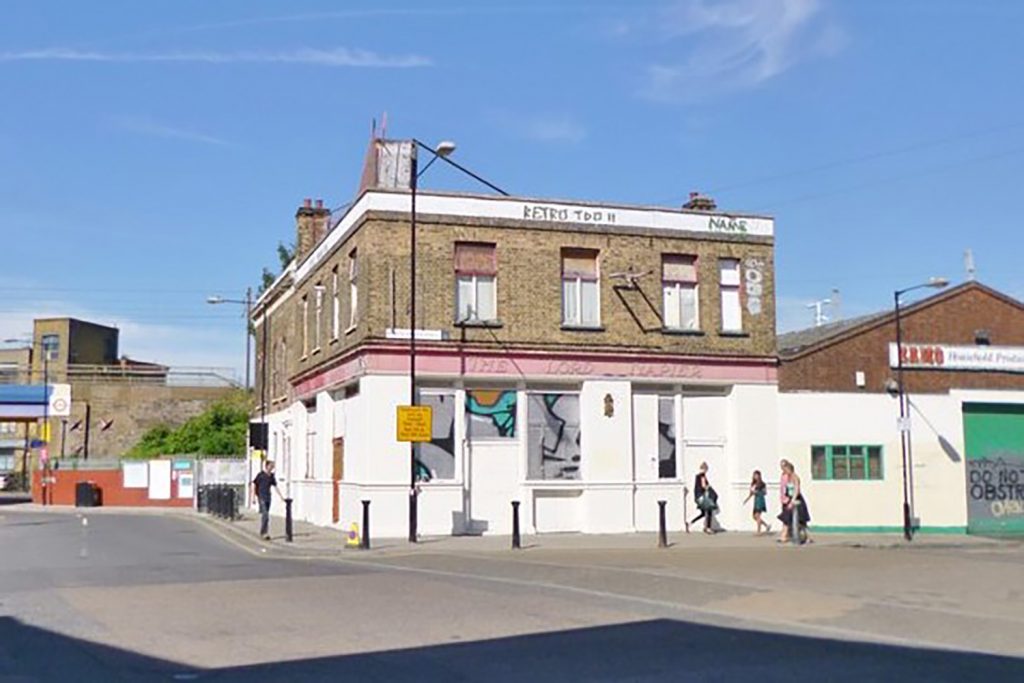
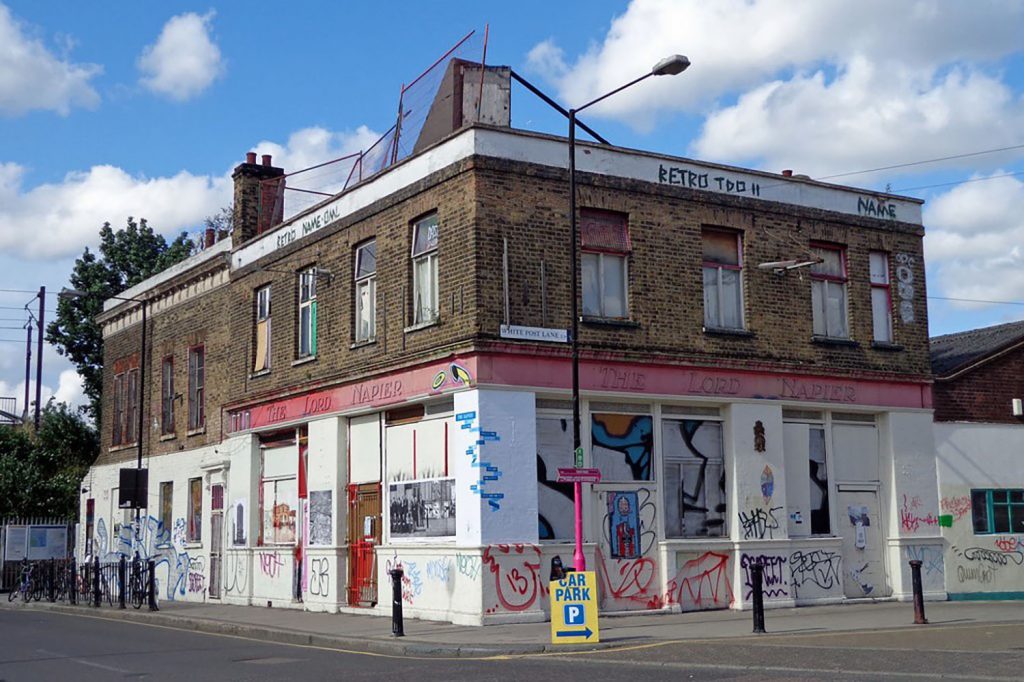
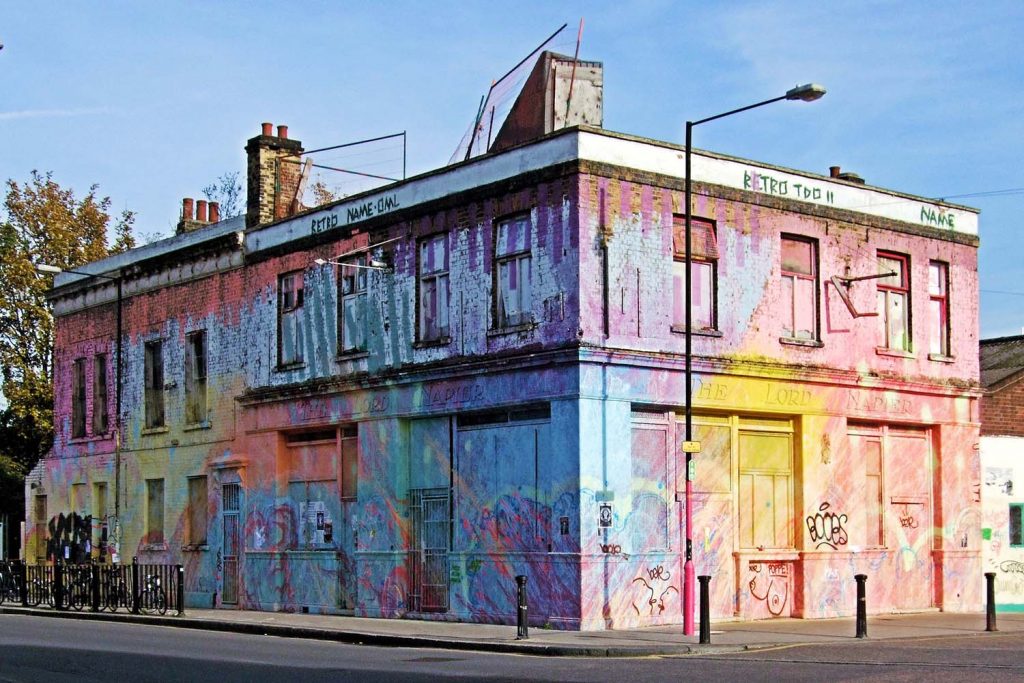
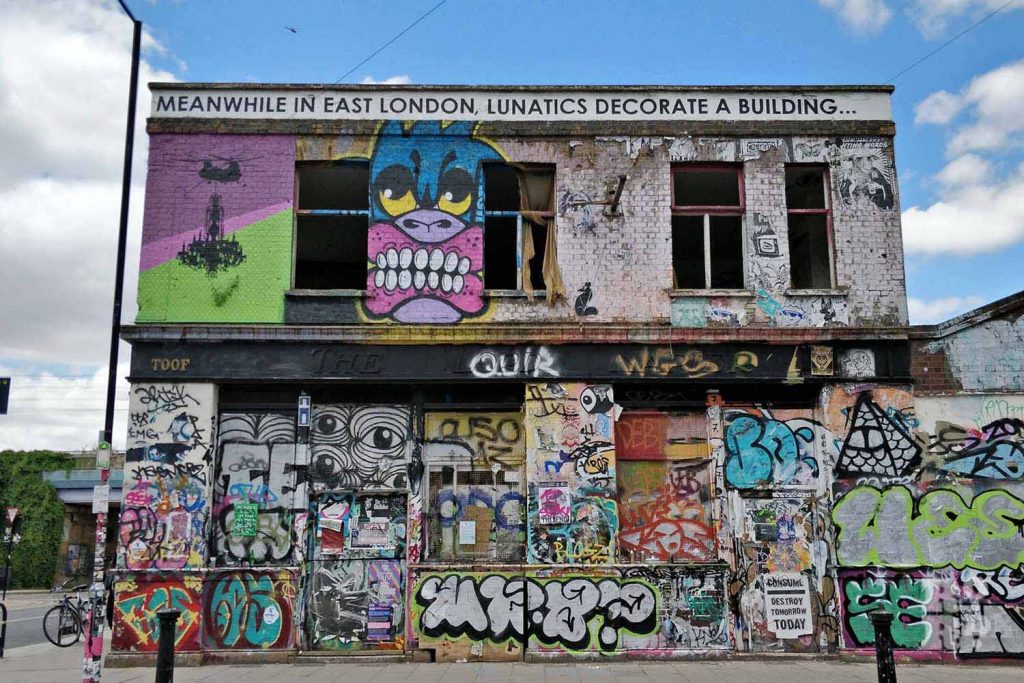
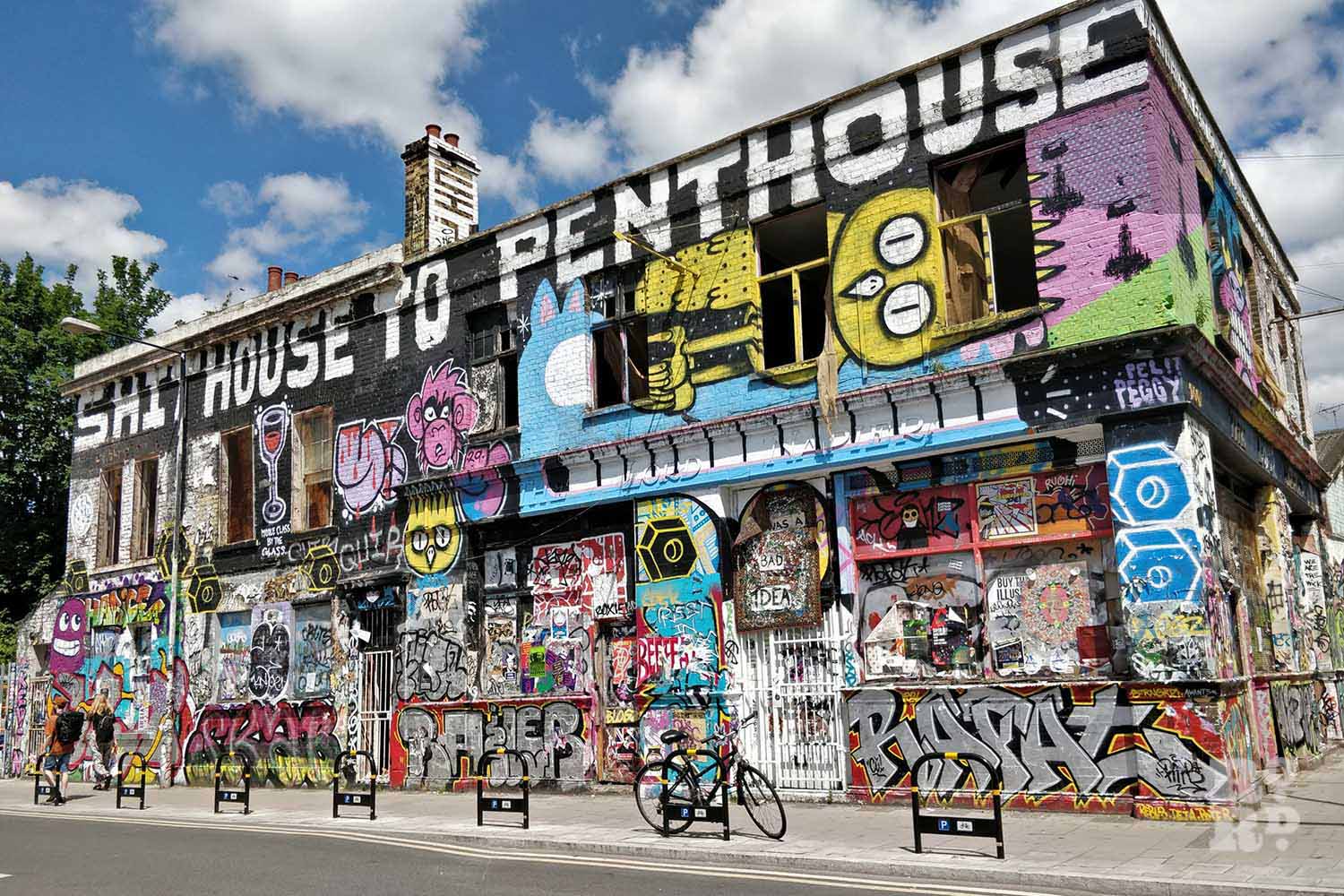
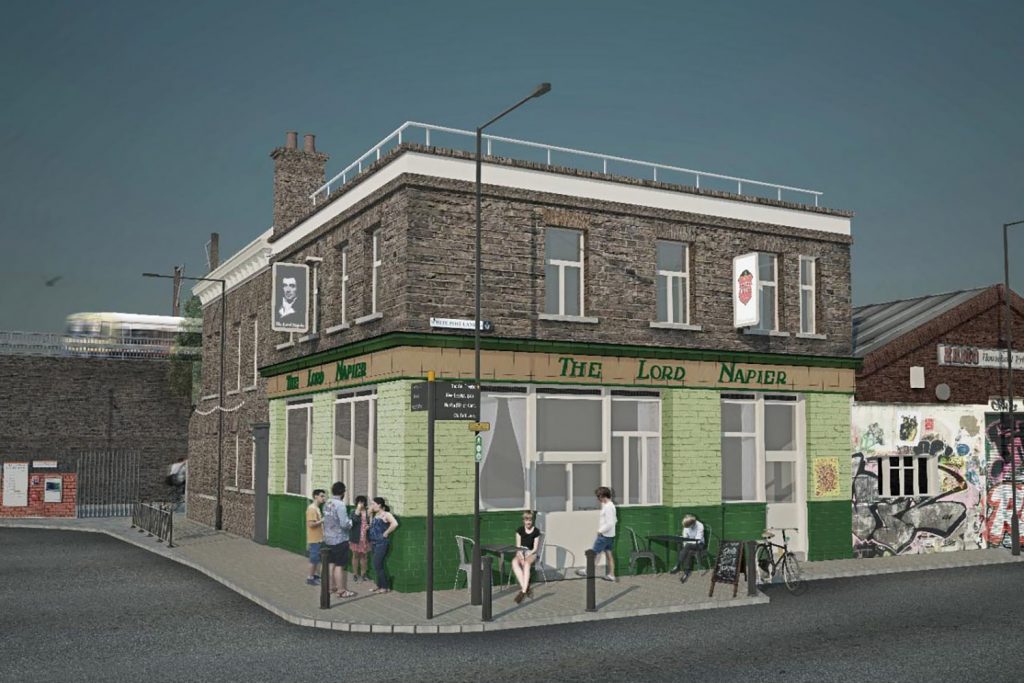
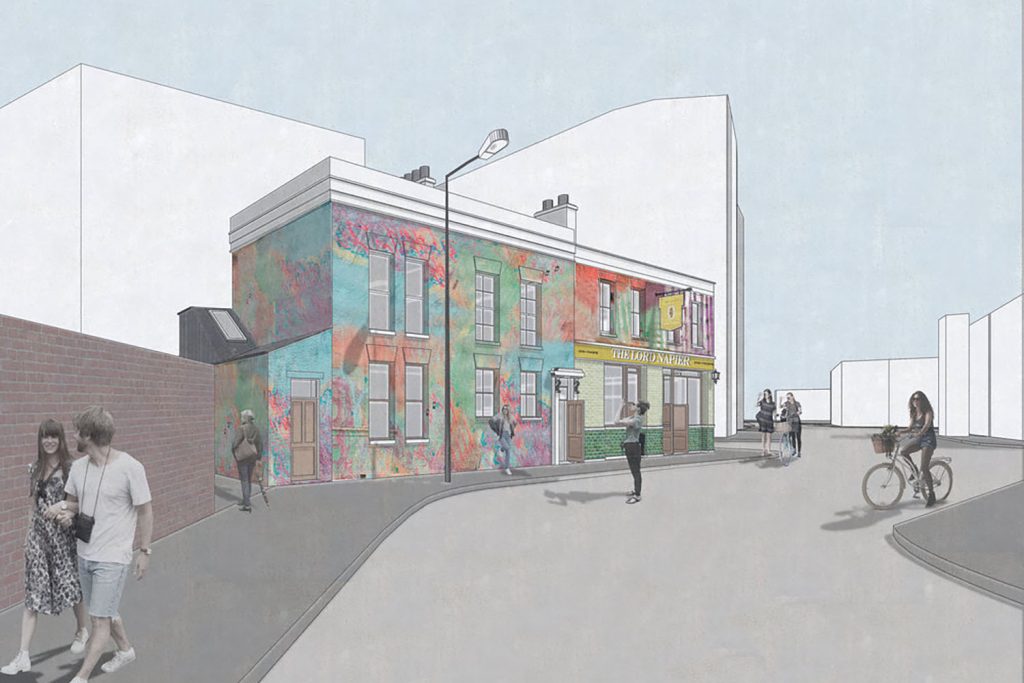
If you enjoyed this, you may like to read about Stour Space, the grassroots art hub of Fish Island

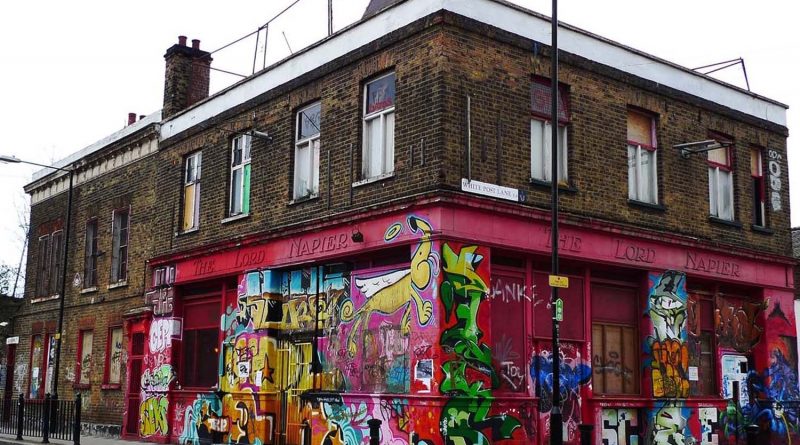

Charles N. Press was Landlord of the ‘Lord Napier’ in 1901 Collingwood Street.
Thanks for sharing Linda! Was that a relative of yours?
Hi my grandmothers dad was the landlord of the Lord Napier between 1938 & 1948.
Would love some more info on him & pub.
My mum was born in pub in1943.
Thanks.
Hi Neil. Is this pub 25 White Post Lane do you know?
Hello, I’m Phil Crumpton (on in-STAG(ram)), I’m Type4Printer. Currently concluding my photography for My Book and project: ‘LANDSCAPES of the DIGITAL World’ and desperate to learn of the fate of the Building (pub). PLEASE REASSURE ME: the LN (Pub) is still standing and has all the community art and fliers still adorning it, please? Sent: Thursday 11th. March 21.
Is the address of this pub 25 White Post Lane? If so, according to the 1939 Census my father (Robert A Hiller) lived here in 1939, aged 19. My grandparents were indeed publicans in the East End so it seems likely. They had the Black Boy in Bethnal Green and The Jane Shore in Shoreditch High Street up until the 1950’s.
My dad enlisted into the RAF that year too.